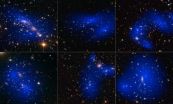Researchers identify timeline for HIV replication in the brain
2015-03-26
(Press-News.org) CHAPEL HILL, NC - A team of researchers has discovered HIV can begin replicating in the brain as early as four months after initial infection. The study followed 72 treatment naïve participants during the first two years of HIV infection. Through analysis of cerebral spinal fluid (CSF) and blood samples, 20 percent of subjects showed replication in the central nervous system (CNS) at four months. Additionally, 30 percent of participants showed evidence of a marked CSF inflammatory response in at least one time point and 16 percent of study volunteers showed a marked CSF inflammatory response at multiple time points, suggesting an ongoing infection in the CNS. The findings will be published in the scientific journal PLoS Pathogens.
"This shows that viral replication and inflammation can occur early in infection with the concern being that the damage caused could be irreversible," says study virologist Ronald Swanstrom, PhD, Director of the University of North Carolina's Center for AIDS Research (CFAR) and Professor of Biochemistry and Biophysics at UNC's School of Medicine. "HIV and inflammation have the potential to accelerate the aging process and cause neurocognitive impairment, in the extreme case resulting in HIV-associated dementia."
One-third of people not taking antiretroviral therapy (ART) to control their HIV will eventually develop HIV-associated dementia, Swanstrom says. For him, the study's results in these newly infected people stress the importance of routine HIV testing to catch the infection as early as possible to allow the prompt initiation antiretroviral therapy.
"This is yet another reason we want people on ART right away to limit the possibility of replication and inflammation in the brain," Swanstrom says.
Future studies could focus on whether or not damage to the brain caused by this early replication and inflammation is reversible. Swanstrom collaborated on the study with senior author and neurologist Serena Spudich, MD, Division Chief of Neurological Infections & Global Neurology and Associate Professor of Neurology at Yale School of Medicine, and neurologist Richard Price, MD, Professor of Neurology at the University of California San Francisco School of Medicine. The first author on the study was a UNC graduate student in the Department of Microbiology and Immunology, Christa Sturdevant, who is now a postdoctoral fellow at Duke University. The study was funded by the National Institute of Mental Health.
INFORMATION:
The mission of UNC's Institute for Global Health & Infectious Diseases is to harness the full resources of the University and its partners to solve global health problems, reduce the burden of disease, and cultivate the next generation of global health leaders. Learn more at http://www.globalhealth.unc.edu.
ELSE PRESS RELEASES FROM THIS DATE:
2015-03-26
The fact that the neutron is slightly more massive than the proton is the reason why atomic nuclei have exactly those properties that make our world and ultimately our existence possible. Eighty years after the discovery of the neutron, a team of physicists from France, Germany, and Hungary headed by Zoltán Fodor, a researcher from Wuppertal, has finally calculated the tiny neutron-proton mass difference. The findings, which have been published in the current edition of Science, are considered a milestone by many physicists and confirm the theory of the strong interaction. ...
2015-03-26
Astronomers using observations from the NASA/ESA Hubble Space Telescope and NASA's Chandra X-ray Observatory have studied how dark matter in clusters of galaxies behaves when the clusters collide. The results, published in the journal Science on 27 March 2015, show that dark matter interacts with itself even less than previously thought, and narrows down the options for what this mysterious substance might be.
Dark matter is a giant question mark looming over our knowledge of the Universe. There is more dark matter in the Universe than visible matter, but it is extremely ...
2015-03-26
Say you're out shopping for basic household goods -- perhaps orange juice and soup. Or light bulbs. Or diapers for your young child. How do you choose the products you buy? Is it a complicated decision, or a simple one?
It could be complex: Factors like price, quality, and brand loyalty may run through your mind. Indeed, some scholars have developed complicated models of consumer decision-making, in which people accumulate substantial product knowledge, then weigh that knowledge against the opportunity to explore less-known products.
But in a new paper, MIT researchers ...
2015-03-26
(WASHINGTON - March, 26, 2015) - A committee of lymphoma experts today unveiled a strategic roadmap identifying key priority areas in both infrastructure and research that will be critical for advancing treatments for people with lymphoma. The report is meant to inform future research directions as well as funding decisions by strategic partners that could include government agencies and the private sector. The strategic recommendations were developed after a review of the state of the science in lymphoma conducted at a special ASH Meeting on Lymphoma Biology held in August ...
2015-03-26
EAST LANSING, Mich. -- It may sound like the makings of a joke, but answering the question of how chickens crossed the sea may soon provide more than just a punch line.
Michigan State University researcher Eben Gering has collaborated with a team in a study of the mysterious ancestry of the feral chicken population that has overrun the Hawaiian Island of Kauai. Their results, published in the current issue of Molecular Ecology, may aid efforts to curtail the damage of invasive species in the future, and help improve the biosecurity of domestic chicken breeds.
Domesticated ...
2015-03-26
Washington, DC (March 26, 2015)--As the world looks to American innovation to fight Ebola, malaria, tuberculosis, and a host of other health threats, a new report released today on Capitol Hill warns budget battles in Washington are eroding preparedness at home and abroad at a time when scientific advances are poised to deliver new lifesaving drugs, vaccines, and diagnostics.
"Since 2009, we've seen declining, or at best stagnating, support for global health research and development, with politics trumping prudent investments that could protect the US and the world from ...
2015-03-26
The expansion of no-take marine reserves (NTMRs) within Australia's Great Barrier Reef Marine Park more than a decade ago is working to protect fish just as experts had hoped it would, say researchers who have been monitoring the reef via underwater surveys. The findings, reported in the Cell Press journal Current Biology on March 26, come as encouraging news for Australia's largest reef and for other, similar projects around the world.
While the park reserves could not protect the reef directly from extensive physical damage caused by Tropical Cyclone Hamish in 2009, ...
2015-03-26
CHAMPAIGN, Ill. -- Using high-performance computing and genetic engineering to boost the photosynthetic efficiency of plants offers the best hope of increasing crop yields enough to feed a planet expected to have 9.5 billion people on it by 2050, researchers report in the journal Cell.
There has never been a better time to try this, said University of Illinois plant biology professor Stephen P. Long, who wrote the report with colleagues from Illinois and the CAS-MPG Partner Institute of Computational Biology in Shanghai.
"We now know every step in the processes that ...
2015-03-26
Scientists have revealed a brand new function for one of the first cancer genes ever discovered - the retinoblastoma gene - in a finding that could open up exciting new approaches to treatment.
The retinoblastoma gene is so called because mutations to it cause a rare children's eye cancer of the same name, and is known to play a central role in stopping healthy cells from dividing uncontrollably.
Now the new study - jointly led by scientists at The Institute of Cancer Research, London, and UCL (University College London) - has found that the gene also has another important ...
2015-03-26
How you feel pain is affected by where sources of pain are in relation to each other, and so crossing your fingers can change what you feel on a single finger, finds new UCL research.
The research, published in Current Biology, used a variation on an established pain experiment, known as the "thermal grill illusion". In the thermal grill illusion, a pattern of warm-cold-warm temperatures applied to the index, middle and ring finger respectively causes a paradoxical, sometimes painful, sensation of burning heat on the middle finger - even though this finger is actually ...
LAST 30 PRESS RELEASES:
[Press-News.org] Researchers identify timeline for HIV replication in the brain




